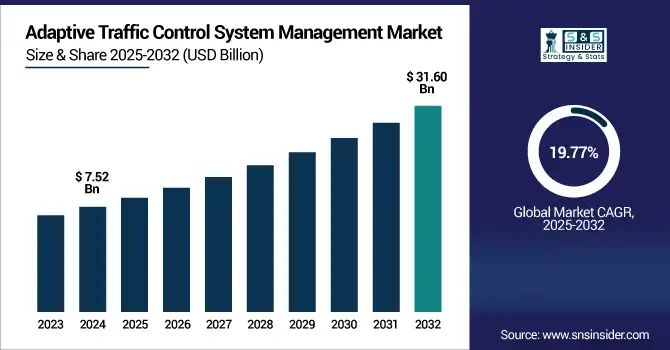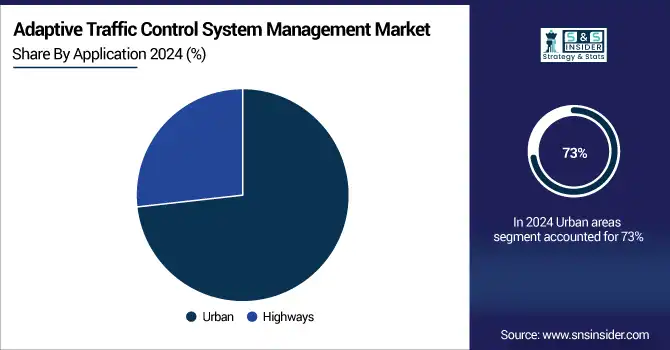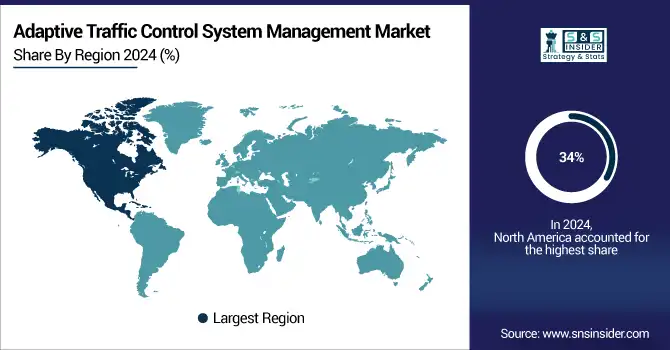Adaptive Traffic Control System Management Market Report Scope & Overview:
Adaptive Traffic Control System Management Market size was valued at USD 7.52 billion in 2024 and is expected to reach USD 31.60 billion by 2032, growing at a CAGR of 19.77% over 2025-2032.

To Get more information on Adaptive-Traffic-Control-System-Management-Market- Request Free Sample Report
The Adaptive Traffic Control System Management Market growth is driven by increasing urban congestion, rising adoption of smart city initiatives, and the need for real-time traffic monitoring and management. Governments are investing in intelligent transportation infrastructure to improve road safety and reduce travel time. Advancements in AI, IoT, and connected vehicle technologies further enhance system efficiency, fueling demand for adaptive solutions across both urban and highway applications.
For instance, a government-backed study in China covering 100 of its most congested cities showed that big-data–driven adaptive traffic signals reduced peak-hour trip times by 11% and off-peak by 8%, while cutting CO₂ emissions by approximately 31.7 million tons annually.
The U.S. Adaptive Traffic Control System Management Market size was valued at USD 1.70 billion in 2024 and is expected to reach USD 3.94 billion by 2032, growing at a CAGR of 11.04% over 2025-2032.
The U.S. Adaptive Traffic Control System Management Market is growing due to increasing traffic congestion, rising investments in smart transportation infrastructure, and federal support for intelligent traffic systems. Integration of advanced technologies including AI and IoT enhances traffic flow and safety, driving market demand.
For instance, cities in California including Los Angeles, San Francisco, San Jose, and Pasadena have deployed over 1,000 advanced traffic signals integrated with approximately 13,000 DSRC-equipped vehicles, according to the U.S. Department of Transportation.
In Pasadena’s I-210 corridor, AI and IoT-powered pilot projects actively reroute traffic and adjust signals in real time based on congestion and incident data, improving both travel efficiency and public safety.
Market Dynamics:
Drivers:
-
Growing Urban Congestion Levels Demand Real-Time Traffic Optimization Through Intelligent Traffic Systems and Smart Signal Management Frameworks
Traffic congestion is a more challenging problem for planners and commuters as urban motorization is accelerating. Adaptive Traffic Control Systems (ATCS) make the signal timings adaptable and able to change in accordance with the real-time data of traffic which lessens the amount of delay and idle time. This makes the flows of traffic far smoother especially at peak times. ATCS are critical in facilitating sustainable urban mobility by enhancing safety, reducing fuel consumption, and supporting overall carbon emissions reduction through the growth of global smart city initiatives.
For instance, London’s SCOOT system achieved a 12.8% reduction in travel time delays and a 4.6% drop in vehicle stops across 600 intersections. In Singapore, the Land Transport Authority’s GLIDE system uses dynamic green wave coordination and features including Green Man+ to extend pedestrian crossing times by up to 13 seconds at over 1,000 junctions.
Additionally, AI-driven smart traffic signals in Singapore have reduced travel times by approximately 30% and cut CO₂ emissions by 15%, around 500,000 tons annually while broader smart mobility initiatives helped reduce peak-hour delays by 25% and saved SGD 150 million each year in productivity losses.
Restraints:
-
High Installation and Maintenance Costs of Adaptive Systems Hinder Widespread Deployment, Especially in Developing or Budget-Constrained Regions
One of the substantial obstacles to the deployment of Adaptive Traffic Control Systems is their high cost for the municipalities. The expenditures for the sensors, controllers, software, and infrastructure are hefty, and maintenance and upgrades present further costs. For smaller cities or those in developing countries, such costs may be prohibitive, and while the benefits of the ATCS later on are substantial, municipalities with limited budgets and numerous possible investment targets may choose to delay them, particularly when they need to cover basic infrastructure instead of advanced digital mobility measures.
In the U.S., under the Federal Highway Administration’s ATCMTD program, the government has issued over USD 96 million in funding to approximately 20 jurisdictions to support the deployment of corridor-wide adaptive systems, sensor networks, and software platforms.
This averages nearly USD 5 million per project highlighting the significant investment needed even in well-funded settings, and further underscoring the financial challenges faced by less-resourced regions.
Opportunities:
-
Integration of AI and Machine Learning Technologies Enhances Predictive Capabilities, Enabling Smarter, Self-learning Traffic Management Ecosystems
Artificial Intelligence and machine learning advancements are paving the way for Adaptive Traffic Control Systems (ATCS) to become proactive systems that predict and address traffic in real time. AI-enabled ATCS are powered by historical data and make decisions by integrating video analytics, sensors, and weather feed, thereby improving the traffic flow. By adapting to accidents and other unpredictable events, optimizing signal timing, and providing faster routes for emergency vehicles, and such smart systems can enhance urban mobility and roadway efficiency.
The Federal Highway Administration defines predictive analytics for traffic management as the fusion of real-time sensor, weather, and historical data to forecast traffic conditions and proactively optimize signal timing.
In the U.S., Nevada and Florida Departments of Transportation have implemented AI-enhanced incident detection systems using CCTV and video analytics, resulting in incident detection that is up to 12 minutes faster and a 17% reduction in crash rates due to improved emergency response and traffic rerouting.
Challenges:
-
Data Privacy and Cybersecurity Concerns Arise with Increased Use of Connected Sensors, Surveillance Systems, and Centralized Control Platforms
Adaptive traffic control systems depend on data from vehicles, cameras, and roadside sensors that may contain sensitive or location-specific data. They can also be combined with cloud platforms to create connected components or systems through IoT, which makes them an enticing target for cybercriminals. The fear of unauthorized access to information and data, system manipulation, or infrastructure vulnerability is a deadly threat. Cybersecurity frameworks, regulatory compliance and public trust issues must be addressed to slow project green lights and burden operating costs.
Segmentation Analysis:
By Application
Urban areas led the Adaptive Traffic Control System Management Market share in 2024, accounting for 73%, owing to an increase in urbanization, traffic volume, and subsequent recurrent congestion problems. On the other hand, smart mobility initiatives are being prioritized by city governments to mitigate travel time, emissions and fuel cost. With superior infrastructure preparedness for sensors, IoT and centralized control systems, urban networks will also be the best candidates for a quick rollout of adaptive traffic technologies on a large scale.
Highways are expected to grow at the fastest CAGR of 21.53% over 2025-2032 due to Increasing emphasis on long-distance travel efficiency and safety drives the growth. By employing adaptive systems to heal bottlenecks, optimizing the freight route, or adding responsiveness on the traffic during an event of peak travel or injury, governments are upgrading national highway corridors. The increasing volume of inter-city traffic and intelligent tolling complements the need for highly scalable, high-throughput, and dynamic highway traffic management solutions.

By Type
SCATS dominated the Adaptive Traffic Control System Management Market in 2024 with a 29% revenue share as the only adaptive traffic control system with a strong track record globally. This enables a centralized and real-time signal optimization that is appropriate for high-density urban settings. The SCATS system is also popular with a modular approach, its legacy systems integration ability, and its performance on variable traffic volumes, making it a popular choice in municipalities and transportation authorities around the world.
ACS-Lite is projected to grow at the fastest CAGR of 23.87% over 2025-2032 as budget-strapped cities look for economical adaptive solutions. This will be attractive for mid-sized urban areas and suburban networks because it is easier to integrate with existing infrastructure and can be implemented with lesser complexity. With ACS-Lite, adaptive features are offered without requiring significant existing infrastructure changes, enabling quicker and cost-effective traffic management upgrades across varied geographies.
By Component
Hardware led the Adaptive Traffic Control System Management Market in 2024 with 47% revenue share as it serves as an essential building block for the entire environment required for monitoring and adjusting traffic at any particular signal in real time. Components such as sensors, controllers and detection systems are vital to the successful running of the ATCS. These parts involve high initial investments and are needed in high quantities for city intersections and corridors, resulting in the segment accounting for the largest market share.
Software is anticipated to grow at the fastest CAGR of 21.63% over 2025-2032, driven by modernization in AI, analytics, and web-based traffic control platforms. With the proliferation of digitized mobility infrastructure in cities, there is an increasing need for scalable, data-driven software solutions that allow for remote sensing, forecasting, and adaptive response. The ability to do continuous software updates, flexibility of integration, and improved intelligence in terms of traffic flow makes this segment a growth driver for next-gen traffic control systems.
Regional Analysis:
North America dominated the Adaptive Traffic Control System Management Market in 2024 with a 34% revenue share owning to increased government funding, early adoption of smart city technologies and matured traffic infrastructure in the region. The U.S. and Canadian cities have focused their key initiatives on reducing congestion, preserving the environment and developing mobility options. Regional overview high vehicle density and matured digital ecosystems have exposed urban and suburban corridors to rapid deployments of adaptive traffic systems supported by abundant vendor presence and technical expertise.
The U.S. dominated due to advanced traffic infrastructure, early smart city adoption, strong federal funding, and high urban vehicle density driving adaptive system implementation.
Asia Pacific is expected to grow at the fastest CAGR of 21.66% over 2025-2032, owing to growing urbanization, increasing traffic congestion, and directs government investments in smart transportation. Markets such as China, India, and other Southeast Asian countries are embarking on massive infrastructure renewal programs. Increasing vehicle ownership across Asia, combined with one of the highest population densities globally, drives the need for adaptive traffic systems that are scalable and cost effective, to address dynamic urban mobility challenges and drive economic growth in the region.
China is dominating the Adaptive Traffic Control System Management Market in Asia Pacific due to rapid urbanization, massive infrastructure projects, and strong government support for smart city initiatives.
Europe is witnessing steady growth in the Adaptive Traffic Control System Management Market trends due to increasing smart city initiatives, stringent environmental regulations, and strong focus on reducing urban congestion through intelligent mobility solutions supported by EU funding and cross-border innovation projects.
Programs, such as CEF Transport and Horizon Europe have committed hundreds of millions of euros toward urban mobility innovations, including adaptive traffic control systems, shared real-time data platforms, and traffic modeling. These initiatives span cross-border pilot projects across Germany, France, Poland, and Spain underscoring the EU’s strategic push for integrated and intelligent urban transport systems.
Germany is dominating the Adaptive Traffic Control System Management Market in Europe due to its advanced infrastructure, strong automation sector, and sustained smart mobility investments.
The Middle East & Africa and Latin America are experiencing gradual adoption of adaptive traffic control systems, driven by urbanization, government infrastructure upgrades, and pilot smart city projects, though challenges like limited funding and uneven technological readiness slow widespread deployment.

Get Customized Report as per Your Business Requirement - Enquiry Now
Key Players:
The Adaptive Traffic Control System Management Market companies are Siemens AG, International Business Machine Corporation, Johnson Controls International Inc., Indra Sistemas S.A., TransCore Atlantic LLC, Cubic Corporation, Swarco Holding Ltd., Kimley-Horn and Associates Inc., SWARCO McCain Inc., TomTom International BV, Kapsch TrafficCom AG, Econolite Group Inc., Miovision Technologies Inc., Q-Free ASA, and Sensys Networks Inc and others.
Recent Developments:
-
In 2024, Siemens AG showcased its advanced urban traffic management systems, including adaptive signal control, at the ITS World Congress in Singapore. Their systems integrate AI and cloud analytics to improve real-time traffic flow.
-
In 2023, Johnson Controls highlighted that its SCATS Adaptive Traffic Control System is operational in over 250 cities worldwide, controlling 35,000+ intersections and major motorways.
| Report Attributes | Details |
|---|---|
| Market Size in 2024 | USD 7.52 Billion |
| Market Size by 2032 | USD 31.60 Billion |
| CAGR | CAGR of 19.77% From 2025 to 2032 |
| Base Year | 2024 |
| Forecast Period | 2025-2032 |
| Historical Data | 2021-2023 |
| Report Scope & Coverage | Market Size, Segments Analysis, Competitive Landscape, Regional Analysis, DROC & SWOT Analysis, Forecast Outlook |
| Key Segments | • By Component (Hardware, Software, Service) • By Type (SCATS, SCOOT, RHODES, ACS-Lite, OPAC, Other Systems) • By Application (Urban, Highways) |
| Regional Analysis/Coverage | North America (US, Canada, Mexico), Europe (Germany, France, UK, Italy, Spain, Poland, Turkey, Rest of Europe), Asia Pacific (China, India, Japan, South Korea, Singapore, Australia, Rest of Asia Pacific), Middle East & Africa (UAE, Saudi Arabia, Qatar, South Africa, Rest of Middle East & Africa), Latin America (Brazil, Argentina, Rest of Latin America) |
| Company Profiles | Siemens AG, International Business Machine Corporation, Johnson Controls International Inc., Indra Sistemas S.A., TransCore Atlantic LLC, Cubic Corporation, Swarco Holding Ltd., Kimley-Horn and Associates Inc., SWARCO McCain Inc., TomTom International BV, Kapsch TrafficCom AG, Econolite Group Inc., Miovision Technologies Inc., Q-Free ASA, Sensys Networks Inc. |

